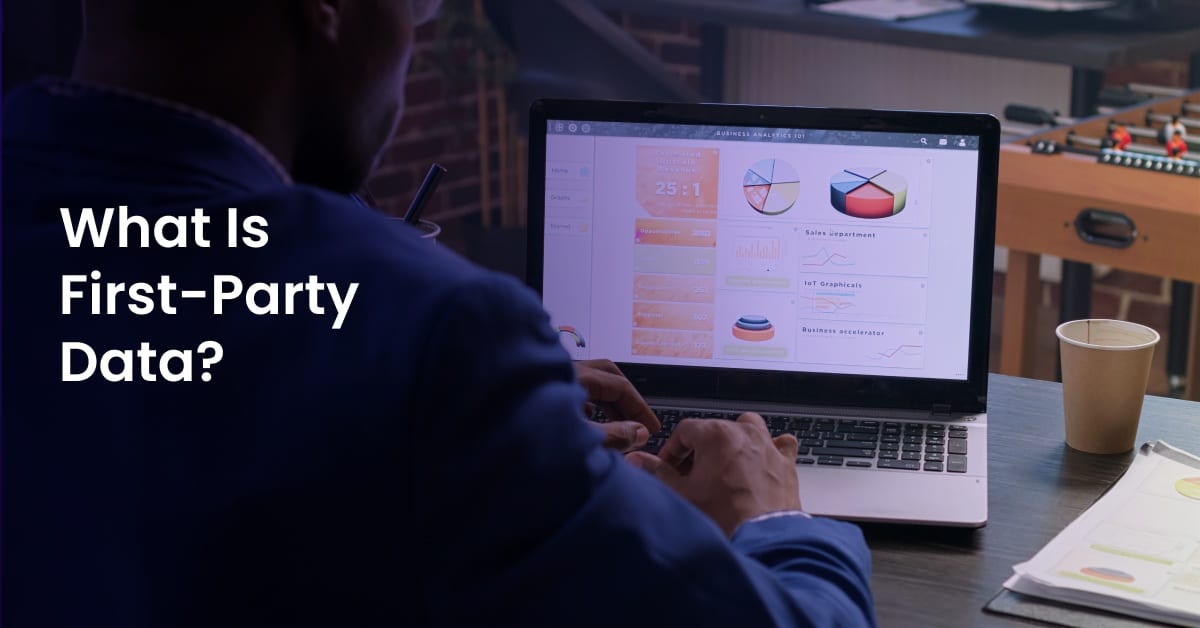Google Chrome, used by over 60% of the world, has killed third-party cookies as of January 2024. So, what’s next for publishers? First-party data is the future.
First-party data is the new, better way to fuel personalized online experiences for your audience and customers. First-party data has been around for a while, but 2024 is the year first-party data rises to the top of your marketing to-do list.
What Is First-Party Data?
To fully understand first-party data, it’s helpful to define it along with a few other commonly used terms. Mastering these concepts makes it easier to plan and collaborate with others.
First-Party Data
First-party data is information a publisher or brand obtains directly from its audience and customers. Some examples of first-party data include a user’s location (inferred based on their IP address), their browser, and which emails they open.
In addition, customer data, such as products purchased and customer addresses, also count as first-party data. First-party data obtained directly from paying customers is one of the most valuable kinds of first-party data!
Since first-party data can take various forms, how do we determine if a given data point counts as first-party data? Ask yourself: did our organization collect this data directly from our audience without any intermediary? If yes, you have first-party data.
Zero-Party Data
This term refers to data that a customer proactively shares with a company. For example, an e-commerce business might run an online poll asking customers to vote on designs for an upcoming product. Customers volunteering data like suggestions, product preferences, and more is also a great sign that you have cultivated a highly engaged customer base.
Second-Party Data
While less commonly used than first-party and zero-party data, you may come across second-party data concerns if you use partnerships.
Second-party data is simply another organization’s first-party data. For example, a news publisher might run a cross-promotion with the local NBA team before the season starts. The data used in this type of promotion may count as second-party data. For example, the two organizations might agree to send messages to their email lists to promote a special pre-season “what to expect this season” live event.
Second-party data and partnerships are powerful ways to grow! There are some considerations to keep in mind with this type of data. You need to check if your privacy policy and your partner’s privacy policy permit this collaboration. In addition, it is wise to be upfront about who you partner with and why. This kind of transparency makes second-party data campaigns more successful.
Third-Party Data
Before 2024, third-party data (especially third-party cookies) was a powerful way to grow online. These cookies allowed publishers and brands to track user behavior across multiple websites, which made it easy to personalize their offerings. Third-party cookies made it easy for advertisers to display highly relevant and personalized ads to users across the Internet.
Third-party cookies are dead today, so it is time to adapt to the first-party data world.
Why Prioritize First-Party Data: 3 Key Reasons
Thriving in a first-party data online environment requires publishers and advertisers to change their focus, methods, and approach. Keep these changes in mind to help you align your team on the new normal.
1) Third-Party Cookies Are Gone!
Google and Apple, which account for over 80% of the world’s web browsers, have ended support for third-party cookies. This is a significant challenge because third-party cookies have fueled many interest-based advertising campaigns.
Publishers can gain an advantage over their competitors by embracing first-party data. When you can offer advertisers detailed information directly gathered from your audience, it’s far easier for your advertisers to grow.
2) First-Party Data Offers A Superior ROI

Google research has found that using first-party data in marketing campaigns leads to a “2.9X revenue uplift.” That’s just the start of the benefits.
Using first-party data in your campaigns also helps you cut costs by up to 1.5X. As a result, publishers can help cost-conscious advertisers stretch their ad budgets further.
3) Focusing on First-Party Data Strengthens Your Business Model
When a business depends on third parties to grow, that model carries a significant risk. What if those third parties change or decide that they don’t like your publication?
This is a real issue that many publishers have already experienced with social media. Many of the social platforms initially offered fantastic, free organic reach. Over time, organic reach has fallen on Facebook and other platforms.
Building deeper relationships with your audience – vital for long-term first-party data success – offers an alternative. When you have a direct relationship, no other company can step in and prevent you from accessing your audience. Even as technology changes, you’ll have direct access to your customers.
Step-by-Step Guide to Kickstarting Your First-Party Data Strategy
By now, you’ve seen the value of focusing on first-party data. Use these steps to integrate first-party data collection and use into your business.
1. Unlock Hidden Value: Inventory Your Existing First-Party Data Assets

The excellent news is that almost every publisher with an online presence is already collecting first-party data. Whew, there’s no need to start from scratch!
In this step, list your most significant first-party data assets. We’ll focus on digital first-party assets that tie back to your website.
- Website. Website visitors constantly share first-party data with you based on the pages they visit, click links, and fill out web forms. Your web analytics platform (e.g., Google Analytics) is your best friend for getting started with this data type.
- Email. Studying how your audience interacts with your email content is one of the best ways to build your understanding of your audience’s preferences over time. There are over 250 million email users in the US, so email is alive and well.
- Mobile Apps. Whether you use them to deliver videos, articles, podcasts, or other content, mobile apps can help gather first-party data.
2. Incorporate First-Party Data Into Campaigns And Tests
Collecting first-party data from your audience is only potential value. For this data to grow your business, you need to integrate it into your marketing and publishing. For example, you may allocate a portion of your marketing budget to test new campaign ideas based on first-party data.
3. Integrate Your First-Party Data Sources
Many companies gather bits and pieces of first-party data across their organization. The marketing team may have great insight into how people use the website and email. At the same time, the sales team owns the CRM and customer conversations. For first-party data to deliver maximum value, combining all your customer data and looking for ways to use it fully is vital.
4. Enhance The Data Value Proposition For Your Audience
First-party data collection and use depends on your audience’s trust. Earning that trust starts with offering a solid value exchange. Determine what your audience will get from sharing their data with you. For example, do they get access to exclusive online experiences (more on this later)?
Keeping trust for the long term also requires protecting your audience’s data as required by law, regulations, and your company’s privacy policy.
5. Offer Unique Experiences To Your Audience
Exciting digital experiences are some of the best ways to keep your audience engaged. When they are engaged on your website for long periods, it becomes easier to gather first-party data. This is where Arena helps publishers to thrive!
Building Sustainable Audience Engagement with First-Party Data
Digital community experiences offer a powerful way to build trust and gather first-party data simultaneously. Here are some ways to use Arena Live Chat and Live Blog to create more engaging experiences for your audience.
Grow Your Reputation For Breaking News Coverage
When a significant news event matters to your audience, offering the latest details is almost irresistible. Imagine your audience is full of basketball enthusiasts who want to know how their favorite teams and players are doing. With Arena Live Blog, you can offer play-by-play coverage of games, game statistics, and pre-game coverage.
As you build a reputation for offering up-to-the-minute information for your audience, they will keep coming back for more. The best part is that your audience will naturally want to know about your live blog coverage. In other words, you have an enthusiastic YES when you ask permission to stay in touch (and gather first-party data).
Offer Unique Connections & Content With Chat
Transform your website into a community hub with Arena Live Chat, which takes just a few minutes to install. Once you have a live chat installed, you can offer a variety of chat experiences to your audience, depending on your goal.
- Want to maximize your audience growth? Offer public chat experiences where anybody can join.
- Want to go deeper with your current audience? Provide invite-only live chat events.
- Interested in growing a new revenue source? Offering paid online experiences with special guests. You can also create this kind of exclusive live chat experience with Arena.
Regardless of how big or small your live events are, Arena Live Chat makes it easy to keep the experience brand-safe through moderation. Our automated profanity filter keeps inappropriate language away. Your staff can also use manual moderation to foster a positive experience.
Publishers: Get More First-Party Data With Arena
Giving your audience a good reason to keep returning to your website is vital to any effort to gather first-party data. Request a demo to see how Arena can help you to grow!



